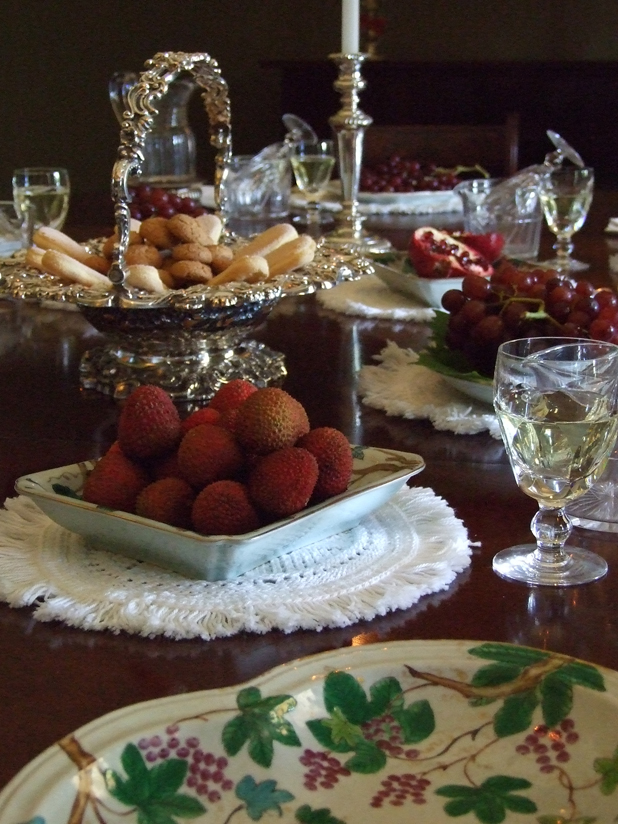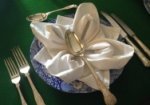While we don’t routinely set the table at Elizabeth Farm, when we do we draw on a wide range of primary sources that describe the Macarthurs’ daily lives as well as wider, but still closely related, colonial themes.
The main image (above) shows a recreation of a breakfast setting for six, with dishes of sliced, pressed tongue and ham, boiled eggs, bread and butter, and breakfast – or ‘French’ – radishes that would freshen your breath and clean your teeth afterwards. Perhaps kedgeree is in one of the covered dishes? We know that Macarthur regularly sent mutton (presumably cold roast mutton, which could be served cold or fried), eggs and milk to Commissioner Bigge and his secretary Thomas Scott for their breakfast. The samovar at the end is placed where Elizabeth could quickly top up a teapot with a blend, probably of her own making. If there were more people the tea equipage could move to a serving table to the side of the room’s chimneypiece.
It’s a very symmetrical, balanced arrangement, reflecting the ordered Georgian floor plan and facade of the house itself: a central vestibule with flanking dining and drawing rooms and the arrangement of the furniture. When I put this table together I imagined it taking place on a relaxed day in the mid 1820s; about to appear are Elizabeth, the sons – James and William, and the daughters – Elizabeth, Mary and Emmeline. Missing is John, a notoriously early riser, who has likely been up since 4 am and is off powering around the estate.
The setting uses chinaware from the collection at Elizabeth Bay House that actually matches a set acquired by James Macarthur a few years later, in the mid 1830s, for the family’s country house, Camden Park. That set, with the addition of the Macarthur crest, can be seen today at the Camden Park house, displayed in a case in the appropriately named ‘china passage’.
If you look closely at the ‘china passage’ photo, you can also see an ornate green patterned plate at the centre of the display case. This is a remnant from one of two dessert services commissioned c1812 from Canton, China by Hannibal Macarthur. One was for his own use and monogrammed ‘H.A.McA.’. The other, from which this is a part, was for his uncle and aunt John and Elizabeth for use at Elizabeth Farm, and carried the dual initials ‘J.E.McA.’
The colony had close, direct links with Chinese trade ports: ceramics, chinaware, textiles, and foodstuffs – and especially tea – all made their way south. It’s particularly interesting that not just merchants but also many of the officers of the NSW Corps, of which Macarthur had been a part, were actively involved in trade, with their finances often conducted through London banking houses. Part of the Macarthurs’ success was due to the close networks of patronage, extended family, and close business associates that they secured.
Typical of dessert services, the Macarther service featured a variety of fanciful shapes, including delicate ‘berry baskets’ with delicately pierced sides. They are all hand painted, with vines and grapes. HHT Members recently commissioned reproductions of these plates, and generously donated a set to Elizabeth Farm.
Here we’ve reproduced a Regency dessert setting using the replica plates, with cakes, sweet biscuits, preserved fruits and sweet wines. A typical addition would be cheeses and biscuits – if the taste of the family ran to cheese that is; this was one of those odd dividing issues that the arbiters of taste bickered over at the time.
Looking at ‘Mrs E’s’ letter of advice, what strikes me is that she seems to omit distinct dessert courses in her menus. She usually provides a first course – with its typical soup, fish, roast fowl and roast – and a second with its blending of sweet and savoury dishes. In a ‘dinner in two removes for 8 or 10 or 12’ persons, for example, the second course includes green beans, crab, baked pears, prawns on toast, tartlets and raspberry cream. However, the menu does not provide the concluding third course you’d expect on a fashionable table. When she does introduce a third course, it’s only as part of a very large formal dinner for 10 to 16 diners. Even then the first course is really just the fish and soup, accompanied by potatoes, striking out on their own: the culinary vanguard for the onslaught to follow.
In later posts I’ll be discussing the details of a Regency setting, laying the table in the à la Française manner, and also looking at ‘servants’ guides’ and how they provide so much of the detail that we use in recreating period interiors. You may be surprised to find out that how you eat today has so much in common with a colonial dinner.
See also:
Broadbent et al, India China, Australia; Trade and Society 1788 – 1850. Sydney, Historic Houses Trust, 2003. pp146-7.
To get an idea of how pervasive and complex the merchant networks were, dive into Merchant Networks.





